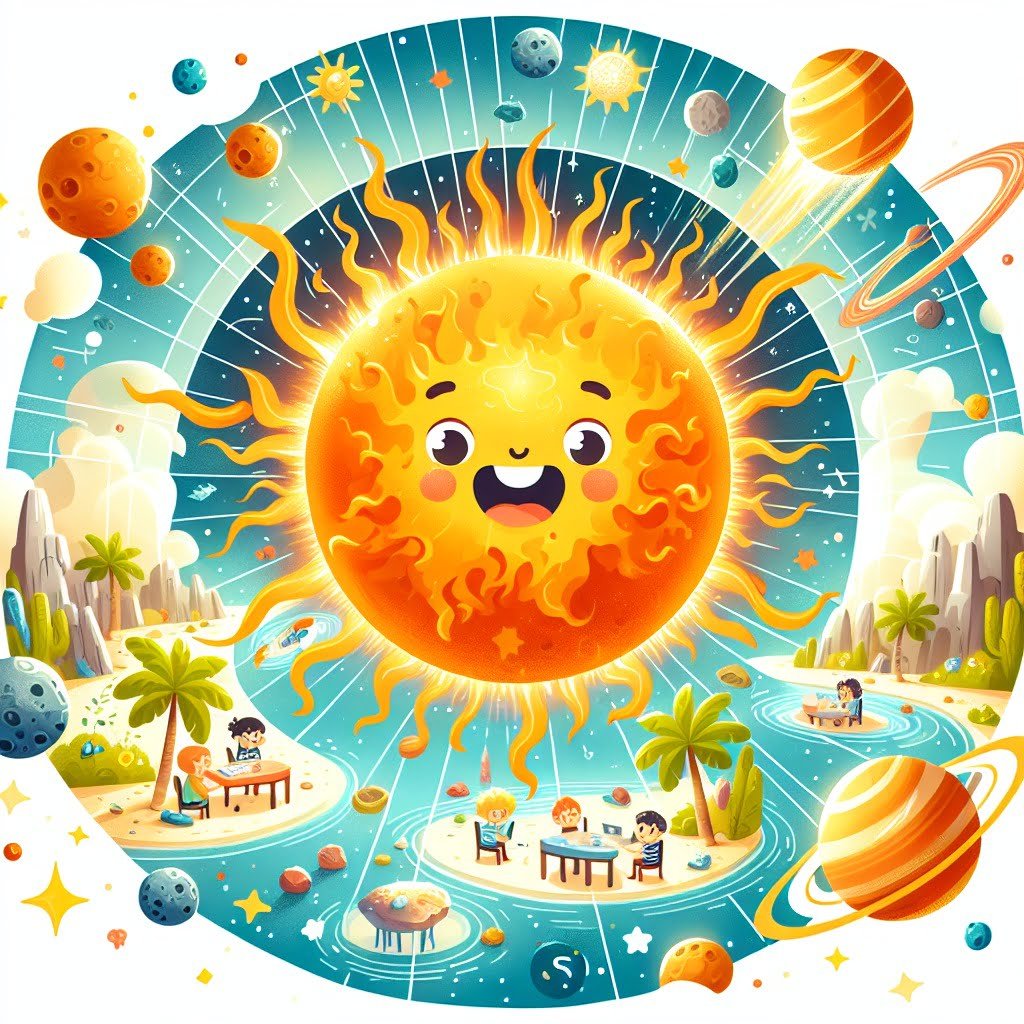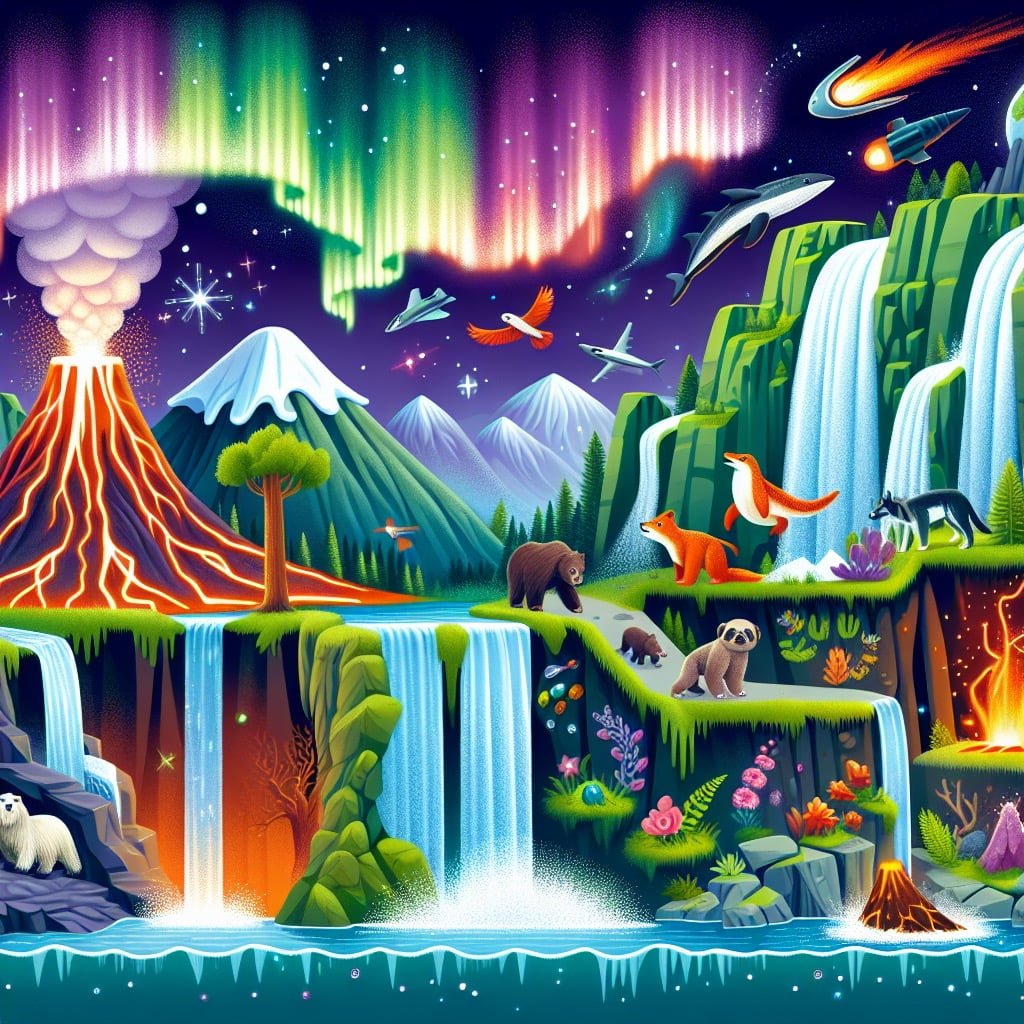Welcome to a fascinating journey through the universe with our blog post on “Sun Facts For Kids.” Delve into the wonders of our nearest star, the Sun, as we explore fun and educational facts about its size, temperature, energy production, and much more. Whether you’re a younger kid marveling at the Sun’s brightness or an older kid intrigued by its complex processes like nuclear fusion, there is something here for everyone. Join us as we uncover the mysteries of the Sun, from its massive size to its crucial role in sustaining life on Earth through photosynthesis. Get ready to be amazed by the incredible facts about the Sun that will leave you in awe of this celestial body that has been shining for billions of years. Let’s embark on this enlightening journey together!
Sun Facts For Kids
1. The Sun is a Star

For younger kids: The Sun is a giant star that gives us light and warmth.
For older kids: The Sun is a massive, luminous ball of gas primarily composed of hydrogen and helium at the center of our solar system.
Detailed explanation:The Sun is a star, but it is much closer to us than any other star in the universe. In fact, it is the closest star to Earth, located at the center of our solar system. The Sun is a massive ball of burning gases, primarily hydrogen and helium, that emits light and heat through nuclear fusion processes happening in its core.
One of the most fascinating Sun Facts For Kids is that the Sun is so large that it could fit about 1.3 million Earths inside it! Its sheer size and mass give it a gravitational force strong enough to hold all the planets in our solar system in orbit around it. The Sun’s gravity also plays a significant role in shaping the paths of comets, asteroids, and other objects in space.
The Sun’s energy is essential for life on Earth. Plants use sunlight to photosynthesize and produce oxygen, which is necessary for animals to breathe. The Sun’s heat also drives weather patterns and ocean currents, influencing Earth’s climate and ecosystems.
Despite its importance, the Sun is just one of an estimated 100 billion stars in our Milky Way galaxy. Each of these stars is a unique entity, with its own size, temperature, and lifespan. As a medium-sized star, the Sun is currently in the middle of its life cycle, steadily converting hydrogen into helium through nuclear fusion. In about 5 billion years, it will exhaust its fuel and expand into a red giant, consuming the inner planets, including Earth, before eventually turning into a white dwarf.
In conclusion, the Sun is not just a bright object in the sky; it is a fascinating star that sustains life on our planet and plays a crucial role in the mechanics of the universe. Remembering these Sun Facts For Kids can help children appreciate the immense power and beauty of the star that lights up our world.
Sun Facts For Kids
2. Sunlight Takes 8 Minutes to Reach Earth

For younger kids: It takes just a few minutes for sunlight to travel from the Sun to us!
For older kids: Sunlight, traveling at the speed of light, takes approximately 8 minutes to reach Earth from the surface of the Sun.
Detailed explanation:One fascinating fact about the sun that is important for kids to know is that sunlight takes approximately 8 minutes to travel from the sun to the Earth. This means that when we look up at the sky and see the sun shining brightly, we are actually seeing the light that left the sun 8 minutes ago.
This incredible journey that sunlight undertakes to reach us on Earth is a result of the vast distance between the sun and our planet. The sun is located about 93 million miles away from Earth, and light, despite traveling at an astonishing speed of 186,282 miles per second, still takes 8 minutes to cover this immense distance.
Understanding this concept helps kids grasp the sheer size and scale of our solar system. It also highlights the incredible speed at which light travels, as well as the concept of time delay in space. Next time children bask in the warmth of the sun or marvel at a sunset, they can think about how the sunlight they are enjoying actually set off on its journey to Earth 8 minutes ago.
Learning about Sun Facts For Kids can be an exciting way to spark curiosity about the natural world and encourage further exploration into the wonders of our universe. It also provides a great opportunity to discuss concepts such as distance, time, and the speed of light in a fun and engaging manner.
Sun Facts For Kids
3. The Sun’s Diameter is 109 Times Bigger Than Earth’s

For younger kids: The Sun is really, really big! It’s much, much larger than Earth.
For older kids: The Sun’s diameter is about 109 times greater than Earth’s diameter, making it a massive celestial body.
Detailed explanation:Sun Facts For Kids can be truly fascinating, especially when considering the incredible size of the Sun in comparison to Earth. The fact that the Sun’s diameter is 109 times bigger than Earth’s is truly mind-boggling. To put this into perspective, if we were to imagine Earth as a small marble, the Sun would be approximately the size of a beach ball.
The Sun is classified as a G-type main-sequence star, which means it is in the middle of its lifecycle, steadily burning hydrogen into helium through nuclear fusion. This process releases an immense amount of energy, which is what provides heat and light to our solar system. Its massive size allows it to exert a strong gravitational pull, keeping all the planets in orbit around it.
From an astronomical standpoint, the Sun’s diameter measures about 1.4 million kilometers, while Earth’s diameter is just over 12,000 kilometers. This stark contrast in size showcases the sheer magnitude of the Sun in comparison to our humble planet.
Understanding the vast size difference between the Sun and Earth can help us appreciate the immense power and influence our nearest star has on our daily lives. From providing warmth and light to sustaining life through photosynthesis, the Sun plays a crucial role in shaping our planet and the entire solar system. Sun Facts For Kids can serve as a great way to introduce young minds to the wonders of the universe and encourage a lifelong interest in science and astronomy.
Sun Facts For Kids
4. The Sun Produces Solar Flares and Sunspots

For younger kids: The Sun can have cool spots and fiery flares on its surface!
For older kids: The Sun experiences solar flares, intense bursts of energy, and sunspots, darker regions caused by fluctuations in magnetic fields on its surface.
Detailed explanation:The Sun, a massive ball of hot plasma and gases, is constantly undergoing intense activity on its surface. One of the most visible manifestations of this activity is the production of solar flares and sunspots. These phenomena are directly related to the Sun’s magnetic field, which plays a crucial role in its behavior.
Solar flares are sudden, intense bursts of radiation that occur on the surface of the Sun. They are caused by the release of magnetic energy in the solar atmosphere. When magnetic fields in different parts of the Sun’s surface become twisted and tangled, they can suddenly snap and release a large amount of energy in the form of solar flares. These flares can be accompanied by a release of energetic particles, which can have effects on Earth’s magnetic field and technological systems such as satellites and power grids.
Sunspots, on the other hand, are dark, cooler regions on the Sun’s surface that are caused by intense magnetic activity. These spots appear darker than the surrounding areas because they are slightly cooler, although they are still extremely hot by Earth’s standards. Sunspots are regions of intense magnetic activity where the magnetic field lines are concentrated. They often occur in pairs or groups and can vary in size and shape.
Both solar flares and sunspots are closely monitored by scientists and astronomers because of their potential impacts on Earth. Understanding these phenomena can help scientists predict space weather events and better protect our technology and infrastructure. Overall, the production of solar flares and sunspots is just one fascinating aspect of the Sun’s dynamic behavior that continues to intrigue researchers and captivate the imagination of kids and adults alike.
Sun Facts For Kids
5. The Sun Will Expand into a Red Giant

For younger kids: Billions of years from now, the Sun will become really big and red!
For older kids: In about 5 billion years, the Sun will exhaust its hydrogen fuel and expand into a red giant, engulfing Mercury and Venus.
Detailed explanation:One fascinating fact about the Sun is that it will eventually expand into a Red Giant. This process is predicted to occur in about 5 billion years, when the Sun exhausts its hydrogen fuel in the core. As a result, the core will start to collapse under the force of gravity, while the outer layers of the Sun will expand outward. This expansion will cause the Sun to increase in size, becoming much larger and brighter than it is currently.
As the Sun expands into a Red Giant, it will engulf the inner planets of our solar system, including Mercury, Venus, and possibly even Earth. This means that in the distant future, the surface of the Earth will become uninhabitable due to the extreme heat and radiation from the expanding Sun. However, scientists believe that by that time, humanity will have either found a way to inhabit other planets or have evolved into a different form altogether.
Despite the destructive nature of the Sun expanding into a Red Giant, it is a natural part of the life cycle of stars. Eventually, the outer layers of the Sun will be ejected into space, forming a beautiful and colorful planetary nebula. The remaining core of the Sun will collapse into a dense white dwarf, gradually cooling off over billions of years.
In conclusion, the fact that the Sun will expand into a Red Giant is a fascinating glimpse into the immense power and lifecycle of stars. It serves as a reminder of the impermanence of our solar system and the universe as a whole. And even though this event is billions of years away, it is a reminder of the need for humanity to continue exploring and understanding the cosmos. Sun Facts For Kids are not only interesting but also serve as a gateway to understanding the vastness and complexity of the universe.
Sun Facts For Kids
6. Sun’s Energy is Produced Through Nuclear Fusion

For younger kids: The Sun makes energy by squishing atoms together really tightly!
For older kids: The Sun’s energy is generated through a process called nuclear fusion, where hydrogen atoms merge to form helium, releasing vast amounts of energy in the process.
Detailed explanation:The Sun is a massive ball of gas, primarily consisting of hydrogen and helium. At its core, temperatures and pressures are incredibly high, which allows for the process of nuclear fusion to occur. Nuclear fusion is the process by which the nuclei of two atoms combine to form a heavier nucleus, releasing a massive amount of energy in the process. In the case of the Sun, hydrogen atoms combine to form helium, releasing an enormous amount of energy in the form of light and heat.
This process is what powers the Sun and allows it to shine brightly in our solar system. The energy produced through nuclear fusion in the Sun’s core is what provides warmth and light to all the planets, including Earth. Without this continuous process of nuclear fusion, the Sun would not be able to sustain itself and eventually burn out.
Understanding how the Sun’s energy is produced through nuclear fusion is crucial in understanding the fundamental processes that govern the universe. It is a fascinating and complex phenomenon that drives the dynamics of our solar system. By learning about Sun Facts For Kids, we can gain a deeper appreciation for the incredible power and energy that the Sun generates through nuclear fusion.
In conclusion, the Sun’s energy production through nuclear fusion is a remarkable process that sustains life on Earth and shapes the world as we know it. It is a fascinating topic that highlights the power and beauty of the natural world.
Sun Facts For Kids
7. The Sun Contains 99.8% of the Solar System’s Mass

For younger kids: The Sun is the heaviest thing in our solar system!
For older kids: The Sun contains a staggering 99.8% of the total mass of our solar system, with planets, moons, and asteroids making up the remaining 0.2%.
Detailed explanation:The Sun is a star at the center of our Solar System, and it plays a crucial role in sustaining life on Earth. One fascinating fact about the Sun is that it contains a staggering 99.8% of the Solar System’s total mass. This means that almost all the matter in our Solar System is concentrated in the Sun, leaving only a tiny fraction of the mass for all the planets, moons, asteroids, and other objects that orbit around it.
The Sun’s immense mass is what gives it its powerful gravitational pull, which keeps all the planets in their orbits and governs the dynamics of the entire Solar System. The Sun’s gravity is so strong that it actually warps the fabric of space-time around it, causing the planets to follow curved paths through space.
The Sun is primarily composed of hydrogen and helium, which are the two lightest elements in the periodic table. These elements undergo nuclear fusion in the Sun’s core, where the intense pressure and temperature create the perfect conditions for them to merge together and release enormous amounts of energy in the form of light and heat. This process, known as nuclear fusion, is what powers the Sun and allows it to shine brightly for billions of years.
In conclusion, the Sun’s massive size and high proportion of the Solar System’s mass make it a central and dominant force in our cosmic neighborhood. Its gravitational influence shapes the movements of all the celestial bodies around it, making it a truly fascinating and essential component of our Solar System. Next time you look up at the sky and see the Sun shining down on you, remember that it contains almost all the mass in our Solar System, fueling life as we know it.
Sun Facts For Kids
8. The Sun’s Temperature Can Reach 15 Million Degrees Celsius

For younger kids: The Sun is super hot—way hotter than anything on Earth!
For older kids: The Sun’s core can reach temperatures exceeding 15 million degrees Celsius, driving the nuclear fusion reactions that sustain its energy output.
Detailed explanation:One of the most fascinating Sun Facts For Kids is that the temperature of the Sun can reach a scorching 15 million degrees Celsius at its core. This unimaginably high temperature is a result of the intense nuclear fusion reactions that take place within the Sun’s core.
Nuclear fusion is the process by which the Sun produces energy. In the core of the Sun, hydrogen atoms collide and fuse together to form helium, releasing a tremendous amount of energy in the process. This energy is what powers the Sun and allows it to shine brightly.
The incredible heat generated by these nuclear fusion reactions causes the Sun’s core to reach temperatures of up to 15 million degrees Celsius. This extreme temperature is what enables the Sun to emit light and heat that sustains life on Earth.
Despite the Sun’s incredibly high temperature at its core, the surface of the Sun is actually much cooler, with temperatures of around 5,500 degrees Celsius. This stark temperature difference between the core and the surface is due to the layers of the Sun’s atmosphere that trap heat and energy generated in the core.
In conclusion, the fact that the Sun’s temperature can reach 15 million degrees Celsius is a testament to the incredible power and energy generated by the nuclear fusion reactions at its core. This remarkable process is what allows the Sun to shine brightly and provide heat and light for the entire solar system.
Sun Facts For Kids
9. Sunlight is Essential for Photosynthesis in Plants

For younger kids: Plants need the Sun to make their own food and grow big and strong!
For older kids: Sunlight plays a crucial role in photosynthesis, a process where plants convert light energy into chemical energy to produce their own food and oxygen.
Detailed explanation:Sunlight is a crucial component for the process of photosynthesis in plants, making it essential for their growth and survival. When sunlight reaches the chlorophyll pigment in the chloroplasts of plant cells, it energizes the electrons and allows them to split water molecules into oxygen and hydrogen. This process, known as photolysis, releases oxygen into the atmosphere and provides the plant with the necessary hydrogen for the next steps of photosynthesis.
In addition to providing the energy needed for photolysis, sunlight also plays a key role in the other stages of photosynthesis. The light-dependent reactions of photosynthesis involve the absorption of light by chlorophyll, which triggers a series of chemical reactions that ultimately produce ATP and NADPH, two molecules that store and transfer energy within the plant cell. These energy-rich molecules are then used in the light-independent reactions, also known as the Calvin Cycle, to convert carbon dioxide into glucose, a form of sugar that the plant can use for growth and metabolism.
Without an adequate supply of sunlight, plants would not be able to carry out photosynthesis effectively, leading to stunted growth, poor reproductive success, and ultimately death. This is why plants that are deprived of sunlight, either due to shade from other vegetation or being indoors, often appear weaker and less vibrant than those that receive ample sunlight. Therefore, it is crucial for plants to be exposed to sunlight in order to thrive and contribute to the overall health of ecosystems. In conclusion, sunlight is indeed essential for photosynthesis in plants, allowing them to harness the energy of the sun to produce their own food and oxygen.
Sun Facts For Kids
10. The Sun Is About 4.6 Billion Years Old

For younger kids: The Sun has been shining brightly for a really, really long time!
For older kids: Scientists estimate that the Sun is approximately 4.6 billion years old, still relatively young in comparison to other stars in our galaxy.
Detailed explanation:Sun Facts For Kids: The age of the Sun is estimated to be around 4.6 billion years old. This fact is truly awe-inspiring when we consider the immense timescale involved. To put it into perspective, the Earth itself is believed to be around 4.5 billion years old, meaning that the Sun has been shining for almost as long as our planet has existed.
But how do scientists determine the age of the Sun? One method involves studying the radioactive decay of elements within meteorites that have fallen to Earth. By analyzing the ratios of different isotopes, researchers can calculate the age of the oldest material in the solar system, which gives us an approximate age for the Sun as well.
Another key piece of evidence for the Sun’s age comes from studying other stars in the universe. By observing the life cycles of other stars and comparing them to our own Sun, scientists can make educated guesses about how long our star has been burning.
The Sun’s age is not only a fascinating scientific fact, but it also has important implications for our understanding of the solar system and the universe as a whole. Knowing that the Sun has been shining for billions of years gives us a greater appreciation for its stability and longevity. It also reminds us of the vast timescales involved in cosmology and the ever-changing nature of the universe.
In conclusion, the Sun’s age of 4.6 billion years is a testament to the incredible longevity of our star and serves as a reminder of the dynamic and ever-evolving nature of the cosmos. By studying the age of the Sun, scientists gain valuable insights into the history and future of our solar system.
Did you know?
Did you know that the Sun’s magnetic field can create solar storms that can disrupt satellite communications on Earth?
Summary of Sun Facts For Kids
Looking up at the sky, we see the Sun shining brightly, but do we really understand the amazing facts behind this celestial body? In this blog post, we explore 10 fascinating facts about the Sun that will capture the imaginations of both younger and older kids alike. From learning that the Sun is a massive star in the center of our solar system, to understanding how sunlight takes just 8 minutes to reach Earth, and discovering that the Sun’s energy is produced through nuclear fusion, there is so much to uncover about our Sun. With fun illustrations and easy-to-understand explanations, this blog post is a great way to engage kids and ignite their curiosity about the wonders of the universe. So, let’s delve into these Sun facts and explore the science that makes our Sun so remarkable!
Sources and additional information for Sun Facts For Kids
WikipediaBritannicaNASAEuropean Space Agency (ESA)Space.comAstrophysical JournalSky & TelescopeUniverse TodaySpaceXThe Planetary SocietyAstronomy MagazineHubbleSiteNational Geographic KidsNASANational Air and Space MuseumESA KidsSpace.comThe Planetary SocietyNational Radio Astronomy Observatory (NRAO)Hayden PlanetariumSky & Telescope




